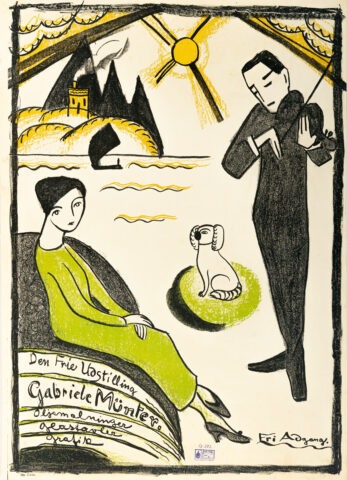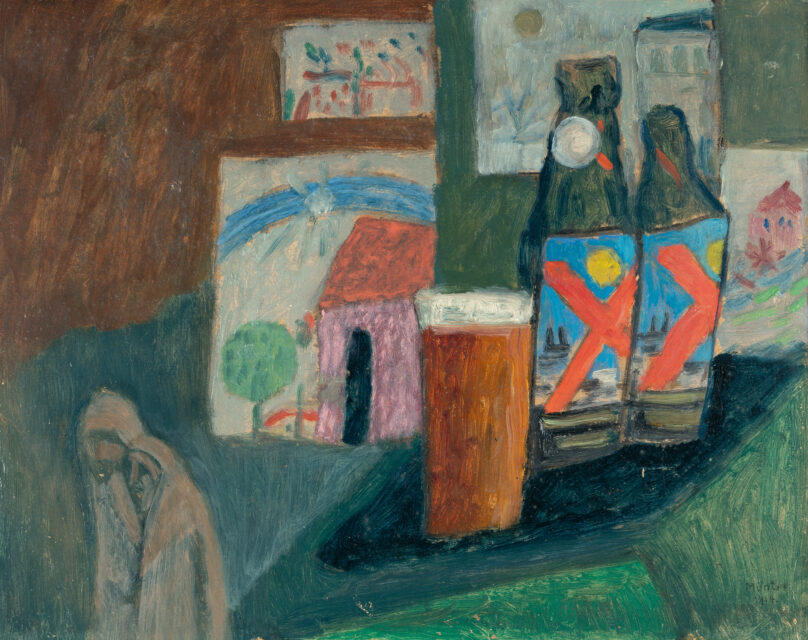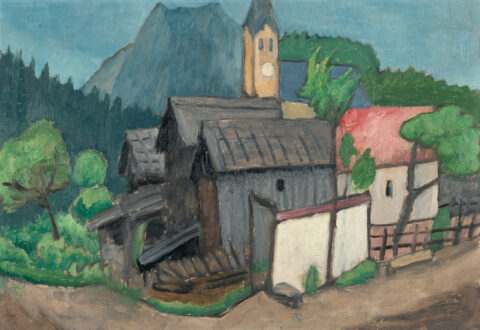
Still life with X beer
Details
This painting is registered with the Gabriele Münter- und Johannes Eichner-Stiftung, Munich, under the number “S 67” (with small labels on the reverse). This work will be included in the Catalogue Raisonné of paintings by Gabriele Münter by the Gabriele Münter- und Johannes Eichner-Stiftung. Exhibitions:Gabriele Münter 1877-1962. Malen ohne Umschweife, Lenbachhaus, Munich et. al. 2018/19, cat. no.146, with col. illus.Provenance:The artist’s estate, with stamp on the reverse (not in Lugt);Gabriele Münter- und Johannes Eichner-Foundation, Munich;private collection, Munich, gifted directly by the aforementioned 1980 to the present owner.
Description
• This painting combines three important groups of motifs within Münter’s oeuvre: still lifes, folk art, and children’s art
• As a picture in a picture, we see Münther’s “House (After a Child’s Drawing)” as well as two naivly carved wooden figures
• From the late period of the Blaue Reiter group, whose members sought inspiration from many kinds of art outside of Academic tradition, encorporating it into Academic art on equal terms Gabriele Münter’s “Still Life with X Beer” is a fascinating image.
In the centre there is a glass of beer on a table, next to it two beer bottles with labels bearing a conspicuous red X. Four childlike drawings or paintings appear in the background. The carved figure of a couple, a man and a woman, turns its back on the cheerful children’s pictures. How do these motifs fit together? Münter painted the work in 1914 – a year that would lead to a turning point in world history as well as a profound turning point in her relationship with Kandinsky. The painting was probably created in Munich, as the artist would probably not have been able to take these children’s pictures with her when she fled Germany after the outbreak of the First World War. Münter and Kandinsky had been collecting pictures and drawings by the children of their friends, acquaintances and family members since 1908. Münter was fascinated by the innocent views of children, who see many things for the first time and therefore perceive them more intensely, as well as the imaginative imagery of children’s drawings. She herself wanted to express “what she feels in the face of an external impression”, i.e. to convey what is invisible. The unfiltered feelings that children convey, the simplification of forms, the concentration on what they percieve as essential corresponded to Münter’s artistic ideals. Children’s drawings are timeless and can be understood across cultures. They help to create a universal visual language. Münter was so fascinated by this art form that she not only collected the images, but also traced parts of them or even copied them in oils. The act of copying gave Münter a way to approach the children’s images. In the present still life, Münter has incorporated her own copy of a child’s drawing in the still life. This picture within the picture is a special testimony to innocence and lack of care: the sun shines over a house, a blue band of clouds stretches across the sky like a rainbow. It is this carefree attitude, this ease, that is now in question, probably shortly before or shortly after the outbreak of war. This is what the couple, who appear to walk out of the picture, have to leave behind. Just like Kandinsky, who as a foreigner had to leave Germany immediately upon the outbreak of the war. Münter will go with him. What remained was the childlike carefreeness and the shared beer of the Bavarian era with Kandinsky.
* All results incl. buyer’s premium (27%) without VAT. No guarantee, subject to error.
** All post-auction prices excl. buyer's premium and VAT. No guarantee, subject to error.
*** Conditional Sale: The bid was accepted below the limit. Acquisition of the work may still be possible in our post-auction sale.
R = regular taxation
N = differential taxation on works of art which originate from a country outside of the EU
The private or commercial use of images shown on this Website, in particular through duplication or dissemination, is not permitted. All rights reserved.




